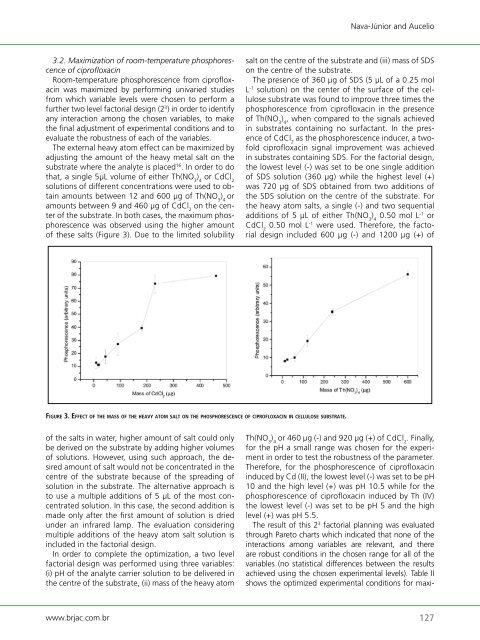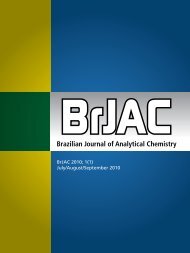Brazilian Journal of Analytical Chemistry - BRJAC - Brazilian Journal ...
Brazilian Journal of Analytical Chemistry - BRJAC - Brazilian Journal ...
Brazilian Journal of Analytical Chemistry - BRJAC - Brazilian Journal ...
You also want an ePaper? Increase the reach of your titles
YUMPU automatically turns print PDFs into web optimized ePapers that Google loves.
3.2. Maximization <strong>of</strong> room-temperature phosphorescence<br />
<strong>of</strong> cipr<strong>of</strong>loxacin<br />
Room-temperature phosphorescence from cipr<strong>of</strong>loxacin<br />
was maximized by performing univaried studies<br />
from which variable levels were chosen to perform a<br />
further two level factorial design (2 3 ) in order to identify<br />
any interaction among the chosen variables, to make<br />
the final adjustment <strong>of</strong> experimental conditions and to<br />
evaluate the robustness <strong>of</strong> each <strong>of</strong> the variables.<br />
The external heavy atom effect can be maximized by<br />
adjusting the amount <strong>of</strong> the heavy metal salt on the<br />
substrate where the analyte is placed 16 . In order to do<br />
that, a single 5µL volume <strong>of</strong> either Th(NO 3 ) 4 or CdCl 2<br />
solutions <strong>of</strong> different concentrations were used to obtain<br />
amounts between 12 and 600 μg <strong>of</strong> Th(NO 3 ) 4 or<br />
amounts between 9 and 460 μg <strong>of</strong> CdCl 2 on the center<br />
<strong>of</strong> the substrate. In both cases, the maximum phosphorescence<br />
was observed using the higher amount<br />
<strong>of</strong> these salts (Figure 3). Due to the limited solubility<br />
<strong>of</strong> the salts in water, higher amount <strong>of</strong> salt could only<br />
be derived on the substrate by adding higher volumes<br />
<strong>of</strong> solutions. However, using such approach, the desired<br />
amount <strong>of</strong> salt would not be concentrated in the<br />
centre <strong>of</strong> the substrate because <strong>of</strong> the spreading <strong>of</strong><br />
solution in the substrate. The alternative approach is<br />
to use a multiple additions <strong>of</strong> 5 μL <strong>of</strong> the most concentrated<br />
solution. In this case, the second addition is<br />
made only after the first amount <strong>of</strong> solution is dried<br />
under an infrared lamp. The evaluation considering<br />
multiple additions <strong>of</strong> the heavy atom salt solution is<br />
included in the factorial design.<br />
In order to complete the optimization, a two level<br />
factorial design was performed using three variables:<br />
(i) pH <strong>of</strong> the analyte carrier solution to be delivered in<br />
the centre <strong>of</strong> the substrate, (ii) mass <strong>of</strong> the heavy atom<br />
www.brjac.com.br<br />
salt on the centre <strong>of</strong> the substrate and (iii) mass <strong>of</strong> SDS<br />
on the centre <strong>of</strong> the substrate.<br />
The presence <strong>of</strong> 360 μg <strong>of</strong> SDS (5 μL <strong>of</strong> a 0.25 mol<br />
L -1 solution) on the center <strong>of</strong> the surface <strong>of</strong> the cellulose<br />
substrate was found to improve three times the<br />
phosphorescence from cipr<strong>of</strong>loxacin in the presence<br />
<strong>of</strong> Th(NO 3 ) 4 , when compared to the signals achieved<br />
in substrates containing no surfactant. In the presence<br />
<strong>of</strong> CdCl 2 as the phosphorescence inducer, a tw<strong>of</strong>old<br />
cipr<strong>of</strong>loxacin signal improvement was achieved<br />
in substrates containing SDS. For the factorial design,<br />
the lowest level (-) was set to be one single addition<br />
<strong>of</strong> SDS solution (360 μg) while the highest level (+)<br />
was 720 μg <strong>of</strong> SDS obtained from two additions <strong>of</strong><br />
the SDS solution on the centre <strong>of</strong> the substrate. For<br />
the heavy atom salts, a single (-) and two sequential<br />
additions <strong>of</strong> 5 μL <strong>of</strong> either Th(NO 3 ) 4 0.50 mol L -1 or<br />
CdCl 2 0.50 mol L -1 were used. Therefore, the factorial<br />
design included 600 μg (-) and 1200 μg (+) <strong>of</strong><br />
fi g u rE 3. EffECt o f t h E m a s s o f t h E h E a v y a t o m s a l t o n t h E PhosPhorEsCEnCE o f C i P r o f l o x a C i n in CEllulosE s u B s t ra t E.<br />
Nava-Júnior and Aucelio<br />
Th(NO 3 ) 4 or 460 μg (-) and 920 μg (+) <strong>of</strong> CdCl 2 . Finally,<br />
for the pH a small range was chosen for the experiment<br />
in order to test the robustness <strong>of</strong> the parameter.<br />
Therefore, for the phosphorescence <strong>of</strong> cipr<strong>of</strong>loxacin<br />
induced by Cd (II), the lowest level (-) was set to be pH<br />
10 and the high level (+) was pH 10.5 while for the<br />
phosphorescence <strong>of</strong> cipr<strong>of</strong>loxacin induced by Th (IV)<br />
the lowest level (-) was set to be pH 5 and the high<br />
level (+) was pH 5.5.<br />
The result <strong>of</strong> this 2 3 factorial planning was evaluated<br />
through Pareto charts which indicated that none <strong>of</strong> the<br />
interactions among variables are relevant, and there<br />
are robust conditions in the chosen range for all <strong>of</strong> the<br />
variables (no statistical differences between the results<br />
achieved using the chosen experimental levels). Table II<br />
shows the optimized experimental conditions for maxi-<br />
127



